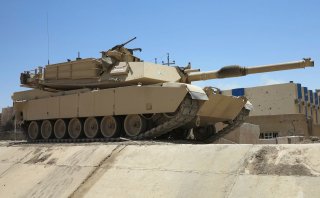Yes, the Army's New Robot Tanks Might Just Be Around the Corner
Really, that soon?
Key point: Robot tanks will help the military scout out and engage the enemy. Meet the latest variants being tested today for use downrange tomorrow.
The U.S. Army future robotic army is taking shape faster, and better, than some officials expected.
“There’s a lot of excitement in industry, in the Army, and we’ve seen industry ahead of our timeline a little bit,” Brig. Gen. Richard Ross Coffman, director of the Next Generation Combat Vehicle Cross Functional Team, told Breaking Defense reporter Sydney Freedberg, Jr. “We are adjusting our expectations.”
This first appeared in 2019 and is being reposted due to reader interest.
After reviewing the unmanned ground vehicle demonstrators that companies are developing for various Army requirements, Coffman told Freedberg he was impressed by the levels of autonomy and modularity.
“Overall, the robots are about two years more sophisticated than expected,” Freedberg wrote, citing Coffman. “Capabilities the service expected in 2023 are now potentially achievable in 2021.”
Between 2020 and 2023 the Army hopes to test three classes of UGV. The Remote Combat Vehicle Light would weigh around 10 tons and come armed with machine guns or rockets in the class of the Javelin anti-tank missile.
The RCV Medium would weigh around 12 tons and carry a 30-millimeter cannon or similar weapons, essentially matching the armament of a manned M-2 infantry fighting vehicle.
The RCV Heavy would be a robotic tank, albeit a lightweight one. Weighing around 20 tons, an RCV Heavy could pack a 120-millimeter main gun.
Several defense firms plan to debut their UGV designs at the Association of the U.S. Army trade show in Washington, D.C. in late October 2019. Vehicle-maker Textron revealed its own Ripsaw M5 UGV, a robotic light tank, in advance of the show.
The Ripsaw could meet the Army’s RCV Light and Medium requirements. The tracked, turreted vehicle “is intended to perform various missions including convoy protection, perimeter defense, surveillance, rescue, border patrol, crowd control and explosive ordnance disposal,” Textron stated.
QinetiQ has been tinkering with its Titan UGV, equipping it with weapons for the RCV Light or RCV Medium roles. In September 2019, a Titan fired multiple Javelin anti-tank missiles at targets on the Army’s Redstone range in Alabama.
“Now, even the ‘heavy’ robot is nowhere near as heavy as a massively-armored M-1 Abrams tank, which weighs 60 to 70 tons,” Freedberg pointed out. “But Coffman argues they don’t have to be, because they don’t have humans inside them to protect.”
Besides, the Army doesn’t want a robotic version of the M-1, Freedberg explained. “Instead, it’s looking at robotic combat vehicles that could be much smaller, cheaper and more expendable than its manned vehicles — five, 10 or 20 tons, officials say -- allowing them to play very different tactical roles.”
“One obvious mission for the robots is sacrificial delaying actions in the face of an overwhelming advance. Yes, human troops can also carry the Javelin, and trained infantry will probably be better at hiding than a robot, even a relatively small one like the one-ton Titan. But once those humans open fire, they will be targeted, and not all of them will make it out.”
The Army conducted some initial UGV testing as early as 2017. That year, an armed, robotic M-113 tracked armored vehicle provided covering fire for soldiers during a war game in Michigan.
For the exercise, engineers added a remotely-controlled machine gun to a remotely-controlled M-113. The operators of the M-113 and its machine gun followed behind the drone in an M-577 command vehicle, issuing commands via radio.
In one of the next major tests of the Army’s UGV force, soldiers riding in a specially-modified M-2s will control a platoon of ground robots during an exercise in Colorado in 2020.
The planned test “moves beyond the basic ‘robotic wingman’ pursuits that have so far led how the mechanized community of the Army is getting at using semi-autonomous and autonomous vehicles,” Army Times reporter Todd South explained.
Army officials intend for the month-long exercise at Fort Carson to gather data for the service’s Ground Vehicle Systems Center. The soldiers in the exercise will operate the unmanned ground vehicles from inside upgraded Bradleys that the Army refers to as “Mission Enabler Technologies-Demonstrators.”
The Colorado war game will involve two of the special M-2s controlling a total of four UGVs, South reported.
Even the unmanned M-113s are surprisingly capable, Coffman told Freedberg. In Michigan, Coffman said he “witnessed four robots execute a maneuver, establish a screen line, call for [artillery] fire, and then attack, with direct fire, an opposing force -- all while the control vehicles were under defilade and undetectable by the enemy.”
Adding ground robots to infantry and armor units “reduces risk,” said U.S. Army major Cory Wallace, who oversees some UGV development for the service. “It does so by expanding the geometry of the battlefield so that before the threat makes contact with the first human element, it has to make contact with the robots.”
"That, in turn, gives commanders additional space and time to make decisions,” Wallace said.
David Axe serves as Defense Editor of the National Interest. He is the author of the graphic novels War Fix, War Is Boring and Machete Squad. This first appeared in 2019 and is being reposted due to reader interest.
Image: Reuters

